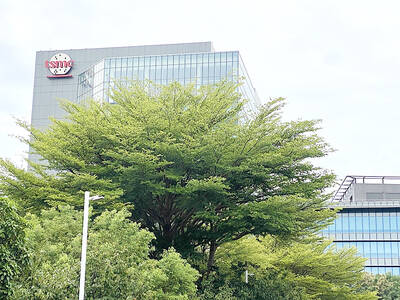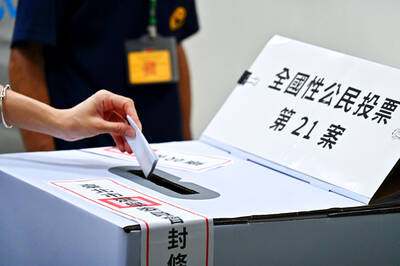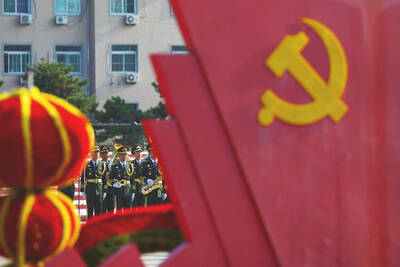High-resolution satellite images show that the construction of China’s first full-sized aircraft carrier is progressing steadily alongside expansive infrastructure work that analysts say suggests the ship will be the first of several large vessels produced at the site.
The images of the Jiangnan Shipyard outside Shanghai were taken last month and provided by the Washington-based Center for Strategic and International Studies (CSIS), building on satellite photographs it obtained in April and September last year.
Noting a series of prefabricated sections, bulkheads and other components stacked nearby, CSIS analysts said that the hull should be finished within 12 months, after which it is likely to be moved to a newly created harbor and wharf before being fitted out.
The vast harbor on the Yangtze River estuary, including a wharf nearly 1km long and large buildings for manufacturing ship components, is nearly complete.
Much of the harbor area appeared to be abandoned farmland just a year ago, according to earlier images that CSIS analyzed.
It dwarfs an existing harbor nearby, where destroyers and other warships are docked.
“We can see slow but steady progress on the hull, but I think the really surprising thing these images show is the extensive infrastructure buildup that has gone on simultaneously,” CSIS analyst Matthew Funaiole said. “It is hard to imagine all this is being done for just one ship. This looks more like a specialized space for carriers and or other larger vessels.”
Singapore-based military analyst Collin Koh (高瑞連) said the modern, purpose-built facility on a sparsely populated island in the Yangtze might provide better security than the congested shipyards of Dalian in northern China.
It could also help deepen cooperation between commercial and military shipbuilders, he said.
The London-based International Institute for Strategic Studies this year said that China’s military shipyards were focusing increasingly on larger surface warships, “adding to the sense that Chinese naval-capability development may be entering a new phase.”
China’s navy has recently launched four Type 055 cruisers and its first large helicopter carrier, known as the Type 075.
China’s military has not formally announced plans for a new carrier, designated Type 002, but official state media have said it is being built.
The Pentagon said it in its annual survey of China’s military modernisation, published in May, that work on a new carrier had begun.
The Chinese Ministry of Defence did not respond to questions from reporters.
Funaiole said the latest images appeared to confirm the earlier photos, which suggested that the latest carrier would be somewhat smaller the 100,000-tonne “supercarriers” operated by the US, but larger than France’s 42,500-tonne Charles de Gaulle.
The images were released by the CSIS China Power Project yesterday.

CHAMPIONS: President Lai congratulated the players’ outstanding performance, cheering them for marking a new milestone in the nation’s baseball history Taiwan on Sunday won their first Little League Baseball World Series (LLBWS) title in 29 years, as Taipei’s Dong Yuan Elementary School defeated a team from Las Vegas 7-0 in the championship game in South Williamsport, Pennsylvania. It was Taiwan’s first championship in the annual tournament since 1996, ending a nearly three-decade drought. “It has been a very long time ... and we finally made it,” Taiwan manager Lai Min-nan (賴敏男) said after the game. Lai said he last managed a Dong Yuan team in at the South Williamsport in 2015, when they were eliminated after four games. “There is

Taiwan Semiconductor Manufacturing Co (TSMC, 台積電) is expected to start construction of its 1.4-nanometer chip manufacturing facilities at the Central Taiwan Science Park (CTSP, 中部科學園區) as early as October, the Chinese-language Liberty Times (the Taipei Times’ sister newspaper) reported yesterday, citing the park administration. TSMC acquired land for the second phase of the park’s expansion in Taichung in June. Large cement, construction and facility engineering companies in central Taiwan have reportedly been receiving bids for TSMC-related projects, the report said. Supply-chain firms estimated that the business opportunities for engineering, equipment and materials supply, and back-end packaging and testing could reach as high as

POWER PLANT POLL: The TPP said the number of ‘yes’ votes showed that the energy policy should be corrected, and the KMT said the result was a win for the people’s voice The government does not rule out advanced nuclear energy generation if it meets the government’s three prerequisites, President William Lai (賴清德) said last night after the number of votes in favor of restarting a nuclear power plant outnumbered the “no” votes in a referendum yesterday. The referendum failed to pass, despite getting more “yes” votes, as the Referendum Act (公民投票法) states that the vote would only pass if the votes in favor account for more than one-fourth of the total number of eligible voters and outnumber the opposing votes. Yesterday’s referendum question was: “Do you agree that the Ma-anshan Nuclear Power Plant

Democratic nations should refrain from attending China’s upcoming large-scale military parade, which Beijing could use to sow discord among democracies, Mainland Affairs Council Deputy Minister Shen You-chung (沈有忠) said. China is scheduled to stage the parade on Wednesday next week to mark the 80th anniversary of Japan’s surrender in World War II. The event is expected to mobilize tens of thousands of participants and prominently showcase China’s military hardware. Speaking at a symposium in Taichung on Thursday, Shen said that Chinese Minister of Foreign Affairs Wang Yi (王毅) recently met with Indian Prime Minister Narendra Modi during a visit to New Delhi.